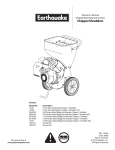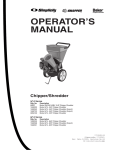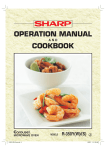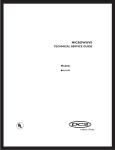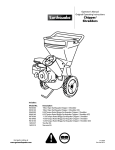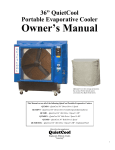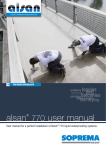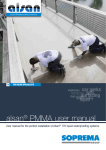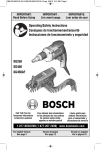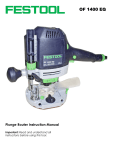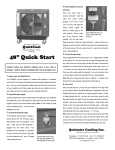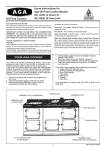Download EarthQuake Beaver Operating instructions
Transcript
IDENTIFICATION OPERATION .............................................................. 11 Description .............................................................. 11 Site Location ........................................................... 11 Checks Before Starting .......................................... 12 Start-up .................................................................. 12 Operating Instructions ............................................. 12 Material Processing ................................................ 14 Shutting Down ........................................................ 14 Waste Materials Guide ............................................ 15 NORMAL CARE ........................................................ 16 Schedule ................................................................ 16 Servicing the Chipper/Shredder ............................... 16 STORAGE .................................................................. 18 Temporary Storage .................................................. 18 Long Term Storage .................................................. 19 TROUBLESHOOTING AND REPAIR ......................... 20 Troubleshooting ....................................................... 20 Repair ..................................................................... 21 OPTIONS & ACCESSORIES .................................... 25 PARTS LISTING ........................................................ 26 MODEL IDENTIFICATION ........................................... 1 WARRANTY ................................................................. 2 SAFETY RULES ......................................................... 3 General ..................................................................... 3 Setting Up ................................................................. 3 Operating Location .................................................... 4 Safe Wearing Apparel ............................................... 4 Operating Safety ....................................................... 5 Transporting & Storage ............................................. 6 Service & Maintenance ............................................. 6 ASSEMBLY ................................................................. 7 General ..................................................................... 7 Tools Required .......................................................... 7 Hardware Description ................................................ 7 Chipper Cone ............................................................ 7 Handle ...................................................................... 7 Hopper ...................................................................... 8 Discharge Bag .......................................................... 8 Engine Oil ................................................................. 8 CONTROLS & MAJOR COMPONENTS ...................... 9 Operating Controls .................................................... 9 Major Components .................................................... 9 MODEL IDENTIFICATION WARNING Record your model number, manufacturer number, and serial number in the space provided for easy reference. The model and manufacturer numbers can be found on the unit I.D. plate. Refer to the Engine Owner's Manual for location of engine serial number. You must read, understand, and comply with all safety and operating instructions in this manual before attempting to setup and operate your rototiller. Failure to comply with all safety and operating instructions can result in loss of machine control, serious personal injury to you and/or bystanders, and risk of equipment and property damage. The triangle in the text signifies important cautions or warnings which must be followed. If you have a service problem requiring special assistance and cannot contact a local dealer to help, call the Customer Service Department at 715-822-2415. CHIPPER/SHREDDER REFERENCE DATA Model Description/Number NOTICE M/N (Manufacturer's Number) S/N (Serial Number) Dealer Name Date Purchased Upon start-up and shut down, you may hear the metal-to-metal sound of the triangular hammers and J-hammers positioning themselves on the rotor. This is a normal sound. If this sound continues after the machine obtains full speed, please contact your dealer for an inspection of your chipper/shredder. ENGINE REFERENCE DATA Engine Make/Model Engine ID/Serial Number WARNING Engine exhaust from this product contains chemicals known, in certain quantities, to cause cancer, birth defects, or other reproductive harm. 1 WARRANTY Thank You . . . for purchasing a Beaver chipper/shredder. We guarantee that this chipper/shredder conforms to applicable North American safety standards, and have worked to ensure that it will meet your exacting standards for usability and durability. With proper care, your chipper/shredder will provide many years of service. Please take time to read this manual carefully to learn how to operate and service your chipper/ shredder correctly. Failure to do so could result in personal injury or equipment damage. This manual should be considered a permanent part of your chipper/shredder. Congratulations on your investment in quality. TWO YEAR LIMITED WARRANTY The Ardisam, Inc., Manufacturing Company warrants this chipper/shredder to be free from defects in material or workmanship. Conditions of this warranty include: What is covered under warranty: For the first year from the date of purchase, Ardisam will furnish 100% parts and labor to correct any defect caused by faulty material or workmanship. During the second year of ownership, Ardisam will furnish 100% of the parts to correct any defect caused by faulty material or workmanship. All repairs made under warranty must have prior approval from Ardisam, Inc. Items subject to normal wear and tear, such as belts, batteries, tines, shear bolts and tires, due to the nature of their function are not covered under this warranty. Any unit used in a commercial application is covered for a period of 90 days after purchase. The engine is covered under a separate warranty issued by the engine manufacturer as stated in the engine manual. What is not covered under warranty: This warranty applies only to products which have not been repaired or altered outside our factory. It covers only defects resulting from normal use, and does not cover defects arising from misuse, alteration, negligence, or accident. This warranty applies only to the original purchaser, and is not transferrable. This warranty supersedes all other warranties either expressed or implied and all other obligations or liabilities on our part. Ardisam, Inc., does not assume, and does not authorize any other person to assume for us, any liability in connection with the sale of our products. This guarantee is void unless the warranty card is properly filled out and returned to Ardisam, Inc., Cumberland, Wisconsin, within two weeks of the purchase date. ARDISAM 2 SAFETY RULES Safe operation of the chipper/shredder unit requires that all operating and safety instructions be obeyed by everyone who uses, services, or otherwise handles the unit. GENERAL The safety alert symbol shown here is used to alert you to important safety information that must be read, fully understood, and followed at all times when handling, transporting, operating, servicing, or storing your chipper/shredder unit. Although the instructions and warnings appearing in this manual cover most normal operating conditions, everyone using the chipper/shredder unit must also always follow safe work practices while operating, servicing, or handling the chipper/shredder unit under any conditions not specifically covered in this manual. Each safety alert symbol is followed by a "signal word" that advised you of the relative intensity, or level, of the hazard the safety alert instructions pertain to. The following list of signal words is being provided to help you understand the intensity levels associated with each signal word used in this manual. SETTING UP • Although most assembly has been done at the factory, your chipper/shredder unit requires minor assembly and the addition of engine oil before it can be used. Never attempt to start or operate the unit unless the chipper cone and shredder hopper have been properly installed and engine oil has been added. • Perform the required assembly in an area where the chipper/shredder can be handled comfortably. Never attempt to assemble the unit unless the engine/base assembly can be held or securely positioned for assembly needs. • Use proper hand tools for assembling the chipper/ shredder. Never use tools such as adjustable openend wrenches that can slip off hardware as it’s being fastened. Never use toothed gripping pliers which may damage hardware and make removal difficult. • Always use only the hardware provided with this unit for assembly. Never substitute parts, or mix the proper position of parts during assembly. If a part is missing, contact your local dealer for an exact replacement. • Assemble the unit in the sequence indicated in the assembly instructions. Make sure all hardware is properly tightened after assembly is completed and before starting the unit. • Make sure all required hardware has been installed. Never attempt to start or operate the unit unless you are sure that all required hardware has been used. • Inspect the shredder hopper and chipper cone for any debris, loose hardware, or other material that may have fallen in during unpacking and assembly. Always disconnect the spark plug wire from the spark plug, before removing any objects. • Never fill the fuel tank indoors! Gasoline vapors are explosive, and can easily travel unnoticed to sources of ignition, such as pilot lights or open flames on water heaters, furnaces, stoves, or dryers, sparks from electric motors and other electrical appliances, DANGER The signal word "DANGER" is used when a serious injury or fatality will result if the safety instructions that follow this signal word are not obeyed. WARNING The signal word "WARNING" is used when a serious injury or fatality could result if the safety instructions that follow this signal word are not obeyed. CAUTION The signal word "CAUTION" is used when personal injury, or property or equipment damage could result if the safety instructions that follow this signal word are not obeyed. DANGER You must read and understand this manual and all safety instructions and labeling completely, before attempting to assemble, setup, transport, operate, service, or install any options or accessories on this unit. This chipper/shredder is a powerful machine designed for chipping of tree limbs and branches up to 2-1/2” in diameter (3” on 8hp or 10hp model), and is capable of amputating or causing serious injury to fingers, hands, feet, and other extremities if accidental contact with rotating chipper and shredder blades should occur. Always keep hands, feet, and other extremities out of the shredder hopper, chipper cone, and discharge area, and never wear loose fitting clothing or jewelry that could get caught on tree limbs, branches, or rotating parts, and pull your hands, or other body parts into the rotating chipper/ shredder blades. 3 SAFETY RULES or unattended smoking materials. Contact with these or any other ignition sources will cause an explosion or fire, serious personal injury, and damage to property and equipment. • DANGER SPARK/FIRE HAZARD GAS ENGINES MAY REQUIRE A SPARK ARRESTER FOR SAFE OPERATION Never overfill the fuel tank. Fuel may run out of the tank and contact hot surfaces on the chipper/ shredder motor and ignite, causing a fire and/or risk of an explosion. Fill fuel tank to 1/2” below bottom of filler neck only. • Use only an approved container for fuel and always handle the container with extreme care. Never smoke while fueling the chipper/shredder or transporting the fuel container. • Never store the fuel container or chipper/shredder indoors where there is a possibility of contact with any ignition source such as a spark, open flame, pilot light, heating element, or smoking materials. • Never attempt to operate a unit indoors or in an enclosed area. Engine exhaust contains Carbon Monoxide, an odorless, colorless, and tasteless gas. If inhaled, Carbon Monoxide can cause dizziness, nausea, unconsciousness, and if contact is allowed to continue, brain damage or death. If the engine on this unit is not equipped with a spark arrester and is to be used on any forest, brush, or grass-covered unimproved land, a spark arrester must be added to the muffler before using the engine on such land. The arrester must be maintained in effective working order by the operator. In the State of California, the above is required by law (Section 4442 of the California Public Resources Code.) Other states may have similar laws. Federal laws apply on federal lands. See your authorized engine service center for muffler spark arrester options. SAFE WEARING APPAREL • Always wear safety goggles to protect your eyes from flying debris when operating the chipper/ shredder. One pair of safety goggles has been provided with the unit for your immediate use. All others in and around the immediate area must also wear approved safety glasses to protect their eyes from flying debris. • Wear hearing protection when the chipper/shredder is to be used for prolonged periods of time, or whenever noise reaches an uncomfortable level. • When wearing work gloves, always wear only properly fitted leather work gloves to protect your hands from cuts and scratches caused by tree limbs and branches. Never wear gloves with pull-ties or straps, as these could get entangled with branches and draw your hands into the chipper cone or shredding hopper cutting areas. • Never wear loose fitting clothing, hanging jewelry, ties, scarves, or other items that could get caught on tree limbs, branches, or moving parts, and draw your body parts into the cutting areas of the chipper cone and shredder hopper. • Always tie up long hair and prevent it from hanging down, where it could become tangled in branches or get caught in rotating parts and pull you into the cutting areas. • Even if you are wearing heavy-duty leather work gloves, never, ever place your hands in the chipper cone or shredder hopper while the unit is running. If you must reach in to clear a jam or free up branches, shut the unit off, disconnect the spark plug wire at the spark plug, and carefully remove or clear the jammed material. OPERATING LOCATION • Always operate the chipper/shredder outdoors only, on a firm, level, earthen or grassy area where the unit will be stable and will stay in position. Never attempt to operate the unit on a slope, or on wet or slippery surfaces where you could slip and fall toward the chipper cone or hopper openings. • Never operate the chipper/shredder on asphalt, concrete, or other hard or paved surfaces, as material being ejected out of the discharge chute could ricochet, causing injury to you or bystanders in the immediate area. • Never operate the chipper/shredder where children, pets, or others who may be unaware of the potential hazards associated with chipping and shredding operations could enter the area unexpectedly and be exposed to these hazards. • Never operate the chipper/shredder on rocky or gravel covered surfaces, as this surface debris could enter the unit and cause extensive damage, or be ejected out of the machine with sufficient force to cause a serious injury to you or bystanders. • Never operate the chipper/shredder in an area where sparks from the muffler could ignite surrounding brush or flammable materials. See following Fire Hazard Warning! 4 SAFETY RULES - Check for loose parts, and loose or missing hardware, and repair or replace as required. OPERATING SAFETY • Always obey the size limitations for tree limbs and branches stated in the Waste Materials Guide portion of this manual. - Check the oil level in the engine crankcase. See the engine service manual shipped with your chipper/ shredder for additional information. • Never leave the machine running unattended. Always turn off the engine, wait for the rotor to come to a complete stop, and disconnect and secure the spark plug wire before leaving the area. Always move the unit to a safe storage area when not in use. • Always maintain secure footing and solid balance while starting or operating the chipper/shredder. Never lean directly over the machine. • Never attempt to clear clogs from the chipper cone, shredder hopper or discharge chute while the unit is running. Always shut the engine off, allow the rotor to come to a complete stop, and remove the spark plug wire from the spark plug before removing excess materials. • Never fill the fuel tank while the machine is running or while the engine is hot. An unexpected spill of fuel could contact a hot surface and ignite, causing fire or explosion. Turn off the engine, and allow the engine to cool before attempting refilling. • Never attempt to perform any maintenance, repairs, or attachment of accessories while the unit is running. Always shut the unit off, allow the rotor to come to a complete stop, and disconnect and secure the spark plug wire from the spark plug before beginning these activities. • Never remove guards, deflectors, or warning labels from the unit. If any of these are found to be missing, take the unit out of service until the appropriate repairs can be made. Tag the machine so others do not mistakenly attempt to use it while awaiting parts or repairs. • Always make sure that the shredding chamber, shredder hopper, and chipper cone are empty before restarting the unit after it has been idle. Attempting to start the unit with material in these areas could cause the engine starting cord to stop suddenly, injuring your hand and fingers, or toppling the unit over. • Never tamper with any engine controls to alter or increase maximum unit running speed. An over speeding condition could cause the engine to overheat, resulting in risk of fire, permanent engine damage, and voiding of your product warranty. • Always comply with the engine manual instructions for operating and periodic maintenance requirements. Make sure the oil level is always in the safe zone, and keep the air filter element clean. • Never allow children to operate the machine. Do not allow adults to operate it without proper instruction. • Always stand to the side of the chipper cone when feeding tree limbs and branches into the unit, as tree limbs, branches, and harder woods may whip around while being chipped. • Always keep hands out of the chipper cone and shredder hopper when feeding materials. Never wrap fingers tightly around branches as you are feeding them into the unit, as a sudden inward surge could pull your hands and arms into the unit. • Always stand clear of the discharge area to avoid being struck by ricochets or material being ejected from the machine. • Never allow material to build up in the discharge area or shredding chamber, as this may cause new material being fed into the machine to kick back with sufficient force to injure you or other bystanders. • Never allow material to build up around the engine during chipper/shredder operation. This could result in a fire or overheating of the engine. • Never attempt to reposition or move the chipper/ shredder unit while it is running. Doing so could cause the machine to tip over, and reaching to steady the unit could result in accidental insertion of your hands into the chipper cone or shredder hopper areas. • Never continue to operate the machine if it starts making unusual noise or vibration. Shut the engine off immediately, allow the rotor to stop, disconnect the spark plug wire from the spark plug, and do the following: - Inspect the unit for any signs of damage or foreign material in the chipping or shredding areas. Remove any solid material that may be preventing the unit from operating properly. 5 SAFETY RULES • • The unit must be shut off before attaching or removing the bag. Shut the engine off, wait for all moving parts to stop, remove and secure the spark plug wire, then attach or remove the bag. Make certain that pieces of metal, rocks, bottles, cans, or other foreign objects are not accidentally included when feeding material into the chipper/ shredder. TRANSPORTING AND STORAGE • Always use the hopper handle and built-in wheels to move the chipper/shredder. Never lift the unit using the fuel tank for support. If the unit must be lifted , always use at least two people, and always grip the unit securely using the front leg and hopper handle. • If the unit must be tilted for transporting, consult the engine manual for required preparation. Normally, fuel and oil must be drained to prevent dangerous fuel leakage, and unwanted transfer of the sump oil into the cylinder head area. • Always refill the engine with the recommended oil before attempting to use the unit again after it has been drained for transportation. • Always observe safe refueling and fuel handling practices when refueling the unit after transportation or storage. • Always follow the engine manual instructions for storage preparations before storing the unit for prolonged periods. • Always follow the engine manual instructions for proper start-up procedures when returning the unit to service. SERVICE AND MAINTENANCE • Before performing any service or repair, shut the engine off, wait for all moving parts to stop, then disconnect and secure the spark plug wire. • Always follow recommended engine and chipper/ shredder procedures when performing required service and maintenance on the unit. • Use only factory authorized replacement parts when making repairs. • Always comply with recommended factory specifications on all settings and adjustments. 6 • Only factory authorized service locations should perform major service and repairs. • Never attempt to make major repairs on this unit unless you have been properly trained and certified to work on large capacity chipper/shredder units. Improper service procedures can result in hazardous operation, equipment damage, and voiding of manufacturer’s warranty. ASSEMBLY GENERAL All of the major assembly procedures on your new Chipper/Shredder were performed at the factory, and only the items listed in this section need to be taken care of to make your unit fully operational. TOOLS REQUIRED • 1/2" Box Wrench or Socket • 7/16" Box Wrench or Socket • 1/4" Hex Wrench • Phillips Screw Driver • Hex (Allen) Wrench Figure 1. Installing the Chipper Cone HARDWARE DESCRIPTION The hardware pack included with your unit contains the items listed below. (Additional hardware may be involved for other models.) Description • BOLT, Hex Head 5/16-18 x 1 • BOLT, Hex Head 5/16-18 x 3/4 • BOLT, Hex Head 5/16-18 x 1/2 • WASHER, Flat 5/16 • LOCKWASHER, 5/16 • CAPSCREW, Hex Socket 1/4-20 x 3/4 • NUT, Flange (Whiz-lock) 1/4-20 • WASHER, 1/4 Qty. 1 2 2 4 2 6 6 4 Figure 2. Installing the Hopper Handle Be sure to clean all hardware threads of paint and debris before assembling. CHIPPER CONE 1. See Figure 1. Position the chipper cone assembly base over the three 5/16-18 threaded studs protruding from the engine plate, and attach using (3) 5/16-18 whiz nuts. 2. Tighten whiz nuts securely using a box or socket wrench. Figure 3. Attaching Hopper to the Rotor HANDLE 1. See Figure 2.Lift the Hopper Handle up until the outer holes in the handle align with the holes in the shredder hopper. 2. Secure the Hopper Handle in position using 1/4-20 x 3/4 hex socket screws, and 1/4-20 whiz nuts, inserting the screws from the outside of the hopper. 3. Tighten all four screws securely. Figure 4. Installing Hardware Inside Hopper 7 ASSEMBLY HOPPER Lift discharge chute and slide bag over chute. Make sure bag noose fits over top of discharge chute and notch in chute bottom. 1. See Figure 3. Attach the hopper to the rotor housing, using care to engage the metal lip of the hopper liner to the inside of the housing. 2. Secure the hopper to the rotor housing using (2) 5/16 x 1/2 hex head bolts and (2) 5/16 flat washers. Do not tighten hardware at this time. 3. See Figure 4. From the inside of the hopper, install (1) 5/16-18 x 3/4 hex head bolt, 5/16 lockwasher, and 5/16 flat washer into each of the upper and lower holes of the metal hopper liner. Do not tighten at this time. 4. Make sure the hopper is properly seated on the rotor housing, and then tighten all hardware securely. Pull drawstring tight DISCHARGE BAG Your unit comes equipped with a bag for collecting debris as it exits the discharge chute. See Figure 5. ENGINE OIL Fill the engine oil sump with the appropriate type of oil required by that type of engine. See the engine service manual shipped with your chipper/shredder for additional information. Figure 5. Discharge Bag Installation 8 CONTROLS & MAJOR COMPONENTS OPERATING CONTROLS C. Bag Your new chipper/shredder has been designed for both ease of use and lasting reliability, and features a simplified control system that required just two operating controls. The two-bushel bag is standard equipment and attaches in seconds for direct, one-step bagging. D. The Support Leg and Wheels The sturdy support leg and wide-track wheels give your chipper/shredder a stable, three-point stance, allowing solid positioning on virtually all surfaces. The large wheel diameter and durable rubber tread design make transporting the unit easy, and the low center of gravity helps prevent tipping while moving over bumpy or uneven terrain. These two operating controls, the Choke and the Throttle, are conveniently located on the chipper/ shredder engine where they can be easily adjusted to start and run the unit under a variety of operating conditions. Choke E. Fan/Rotor Housing The choke controls the fuel to air ratio, and helps make cold starts easier by providing a rich, easily ignited fuel mixture. This housing assembly contains the chipper knives and shredding hammers that process the materials you’ll be chipping and shredding Throttle F. Engine The throttle controls engine speed, and allows you to conserve fuel when idling, or to run the unit at maximum speed for optimal chipping and shredding performance. The rugged, four-cycle, air cooled engine provides all the power necessary to readily chip or shred a wide variety of materials. See the engine service manual shipped with your chipper/shredder for additional information. MAJOR COMPONENTS The major components of your chipper/shredder are: • Shredder Hopper • Discharge Chute • Bag • The Support Leg & Wheels • Fan/Rotor Housing G. Chipper Cone The rugged chipper cone helps guide tree limbs and branches directly into the chipper knives, and it’s unique angled mounting helps pull the material in quickly for aggressive chipping action. • Engine • Chipper Cone Shredding Hammers • Chipper Knives Shredding Hammers (Not Shown) The unique design of the patented free-swinging, triangular shredding hammers and “J” hammers helps pull material into the shredding chamber, and increases volume-reduction efficiency more than most other brands. Each of these major components serves a specific function on the chipper/shredder. Please take a moment and familiarize yourself with the name, location, and function of these components so that you will better understand the safety and operating instructions provided in this manual. See Figure 6. The revolutionary design of these triangular hammers also provides 300% more shredding power than conventional fixed rectangular hammers, and since they can be rotated, their six different usable cutting edges help extend service life dramatically. A. Shredder Hopper The durable, low-profile design of the shredder hopper makes shredding convenient, yet holds a full size load of material for maximum processing capability. Chipper Knives (Not Shown) Our chipper/shredder line also features high quality, precision-tempered, solid steel chipper knives, which can be sharpened again and again to extend their useful life for many seasons to come. B. Discharge Chute The discharge chute ejects the material out of the chipper/shredder, delivering processed materials to a specific area. The pivoting deflector shield directs debris down, while allowing soft materials to be ejected freely from the machine. 9 CONTROLS & MAJOR COMPONENTS A G Optional Vacuum Kit B F C E D Figure 6. Component Locations MODEL SPECIFICATIONS SPECIFICATIONS Horsepower 5.5 hp & 6 hp 8 hp & 10 hp Chipping Capacity 2 1/2" 3" Chipping Knives 2 2 Shredding Hammers 2 - Triangular 2 - J Hammers 2 - Triangular 2 - J Hammers Shredder Capacity 1/2" x 18" Long 1/2" x 18" Long Waste Reduction Ratio Up to 20:1 Up to 20:1 Approximate Weight 97 lbs. 119 lbs. Optional Equipment Vac Kit w/Leaf Tray, Vacuum End, & Tow Bar Vac Kit w/ Leaf Tray, Vacuum End, & Tow Bar 10 OPERATION These spinning fan blades also create a blowing force that ejects the shredded or chipped material out of the discharge chute, making room for more material to be pulled in and processed. DESCRIPTION General Your new chipper/shredder is designed to permit years of trouble-free operation while handling a wide range of chipping and shredding needs. Optional Vacuum Attachment The vacuum force created by the design of the fan blades and rotor makes it possible to equip your chipper/shredder with an optional vacuum attachment that greatly simplifies the processing of leaves and other loose waste. The vacuum kit attaches directly to the back of the grinder, and after a cover is placed over the shredder hopper, the vacuum action is diverted to the vacuum attachment. To help you get the most out of your investment, as well as to help you understand how the unit works, this section explains the basic operation of the chipper/ shredder. Chipper Operation The chipper is designed to handle tree limbs and branched up to 3” in diameter (2-1/2” on models with 5.5 hp & 6 hp engines). The powerful motor and durable chipping knives also permit the unit to process tough organic matter such as corn stalks and berry canes. The vacuum kit allows leaved to be raked directly into the leaf tray, where vacuum action draws the material into the shredding chamber. For hard-to-reach places, a nozzle and handle assembly can be used to vacuum material up much like a vacuum cleaner. The strength of the vacuum can be adjusted for different situations by turning a sleeve on the assembly. Tree limbs and branches are inserted “butt end” first into the chipper cone and are fed into the chipper block, where two chipper knives mounted on a heavy duty rotor rotate at 3600 rpm. The sharp cutting edges and angle of the blades actually pulls the tree limbs and branches into the chipper block, cutting wood into small chips, and promoting rapid material processing. SITE LOCATION 1. Select an area with firm level ground, covered by dirt or grass. Do not operate on wet, slick surfaces or in areas with heavy pedestrian traffic. The chips of material then pass through a slot in the rotor behind the chipper knives, where discharge air flow conveys them through the fan chamber and out of the discharge chute. 2. Locate the unit near the waste materials to be processed to reduce lifting and carrying. 3. Trim and stack the materials for more efficient and safe operation of the chipper/shredder unit. Shredder Operation The shredder is designed to shred light brush, leaves, and other soft but bulky organic waste. As this material is loaded into the shredder hopper, it is pulled into the path of patented swinging triangular and “J” shaped shredding hammers. 4. Provide sufficient room for maneuvering around the chipper/shredder. Never set up the work area so that operators must reach over the chipper/shredder or have to step over materials to be processed. The hammers cut and grind the waste into progressively smaller pieces, and air flow then conveys the reduced waste out of the discharge chute. 5. Review all operating safety instructions before proceeding. DANGER Internal combustion engines produce Carbon Monoxide, a colorless, odorless, and tasteless gas that can cause dizziness, nausea, unconsciousness, and even brain damage or death is inhaled for prolonged periods. Because of this unique swinging hammer design and triangular shape, the chipper/shredder has 300% more shredding power than conventional rectangular shredding hammers used by others. The Vacuum Action Operate the chipper/shredder outdoors in a well ventilated location only. In addition to the shredding hammers and chipping knives, the rotor has four fan blades integrated into its design. When the rotor is spinning, a vacuum action is created, which pulls waste down into the shredder hopper and into the grinding chamber. Keep children, pets, and bystanders away from the operating and discharge areas. Failure to follow these instructions may result in serious injury or death to you or bystanders. 11 OPERATION 6. When engine starts, gradually move choke lever to “no choke” position and increase throttle speed. CHECKS BEFORE STARTING 1. Inspect the chipper cone and shredder hopper for debris and other objects that may have fallen into the machine while the unit was stored, and remove them before starting the unit. Before reaching into the openings turn off the ignition and disconnect and secure the spark plug wire. 7. Adjust throttle speed to “high” for best chipper/ shredder action. Restarting A Warm Engine Restarting an engine that is already warm from previous running does not normally require use of choke. 2. Inspect the chipper cone and shredder hopper, and make sure that they are firmly attached to the housing. 1. Move throttle to “Start.” 2. Place foot on front support leg to hold unit firmly in place, and adopt a stable stance. 3. Check all parts to ensure that they are properly attached and that all fasteners are properly tightened. 3. Pull starting rope out rapidly until engine starts. Allow rope to return normally. 4. Make sure the discharge chute deflector pivots freely, allowing mulch to be discharged freely. If the deflector does not pivot, loosen the mounting screw slightly to reduce tension on the pivot point. 4. Adjust throttle speed to “high” for best chipper/ shredder action. 5. Before attempting to start the engine, make sure: • Engine oil is full. • No fuel has spilled onto engine or surrounding components. • All hardware and parts are properly secured. • No foreign objects are in chipper cone or shredder hopper. • Your clothing is not excessively loose or hanging down, and you are not wearing jewelry or other articles that could get caught in the machinery. Idle Speed STARTING UP OPERATING INSTRUCTIONS The controls required to start and run the chipper/ shredder are located on the engine, and are marked “Choke” and “Throttle.” General Use the “Low” position on the throttle lever to reduce stress on the engine when chipping or shredding is not being performed. Lowering the engine speed to “idle” the engine will help extend the life of the motor, as well as conserve fuel and reduce the noise level of the equipment. Operating Speed For normal chipping, shredding, and vacuuming operation set the throttle level to “Fast.” Your chipper/shredder is easy to set up and operate, but requires simple precautions that are very important, but easy to follow. See the engine service manual shipped with your chipper/shredder for additional information. Please review the following instructions and illustrations carefully. Always comply with these and all other safety and operating instructions in this manual, and on warning labels on the chipper shredder unit, whenever handling or operating this machinery. Cold Starts 1. Move choke lever to full choke position. 2. Move throttle lever to “Start.” Always wear safety goggles when operating the chipper/ shredder. Never allow anyone to operate the unit or remain in the immediate area unless they are wearing approved safety goggles. 3. Place foot on front support leg to hold unit firmly in place, and adopt a stable stance. 4. Pull starting rope out slowly one time and allow to return normally. Proper Stance for Chipping Always maintain a stable, well-balanced stance to one side of the unit when operating the chipper/shredder. Never stand directly in front of the chipper cone when performing chipping operations, since occasional 5.Pull starting rope out rapidly and allow to return normally. 12 OPERATION kick backs may occur, and result in you being struck by the tree limb or branch being kicked back. Hold tree limbs and branches carefully to maintain control as they are being fed into the chipper cone, letting the selffeeding action of the unit pull the material in. Never wrap your fingers around tree limbs and branches so tightly that you can’t let go quickly if the tree limb or branch is suddenly pulled into the chipper block or shredder hopper area. Leaves and other lightweight organic matter can be quickly shredded in your chipper/shredder and reduced to 1/20th of their original volume. Place material to be shredded into the shredder hopper. Avoid large amounts of wet material that can cause shredded matter to build up in the discharge chute and prevent proper discharge. Alternate the processing of dry and wet materials to help prevent clogging of the discharge chute. When time permits, let wet material dry out for a few days prior to shredding. Figure 8. Feeding Materials for Shredding Properly Feeding Longer Materials For Shredding When processing brush, small branches, or other long types of organic matter, feed the materials to be shredded into the shredder hopper lengthwise, butt end first, to prevent clogging of the hopper. If brush gets tangled and clogged as it’s being fed into the hopper, never reach into the hopper to clear it while the unit is running. Shut the engine off, let the rotor come to a complete stop, and disconnect and secure the spark plug wire before attempting to clear the hopper. NOTE: Be sure to shut off the engine and allow the rotor to stop completely before emptying the bag. Figure 9. Properly Feeding Longer Materials for Shredding Figure 7. Proper Stance for Chipping 13 OPERATION 6. Cut any leftover material in to 1” pieces and process the through the shredder hopper. MATERIAL PROCESSING General Most materials to be processed can be handled more efficiently by observing the following chipper/shredder operating tips: SHUTTING DOWN DANGER Engine and surrounding parts become extremely hot during normal use, and will cause serious burn injuries if touched before the engine has cooled. Shredding 1. Do not overload the shredder hopper by dumping large volumes of material into the hopper opening. Allow engine to cool completely before touching these hot surfaces. 2. Alternate wet and dry material to prevent the discharge chute from becoming plugged. 3. Never use any object to force material into the shredder chamber. It could get caught in the shredding hammers and damage the unit, reducing shredder hammer effectiveness. When you’re done using the chipper/shredder, following these simple but worthwhile steps will help you shut down the unit properly so that your next use will be trouble-free. Chipping 1. When you have completed processing the materials to be chipped or shredded, shut the engine off and allow the rotor to come to a complete stop before proceeding. 1. Prune tree limbs and large branches to limit size to the maximum diameter allowed. Pruning tree limbs and branches close to the main portion of the limb or branch will make feeding into the chipper cone easier, and will help you maintain control as the material is drawn into the chipper block. 2. Remove the spark plug wire from the spark plug to prevent the possibility of inadvertent starting. 3. Inspect the following areas for any remaining materials that may have built up or become caught during the final chipping and shredding operations: 2. Large, hard, or dried-out tree limbs that tend to resist chipping can be processed by rotating them manually as you alternately insert and retract them in the chipper cone. • SHREDDER HOPPER Visually inspect inside of shredder hopper, and remove any material remaining inside. 3. If the material to be chipped is extremely hard and kicks back forcefully, or cannot be easily controlled while it is being fed into the unit, remove the material immediately and set it aside. You may need to sharpen the chipper blades to process the material. Consult the maintenance and service section of this manual for sharpening instructions, or take your unit to an authorized service center for prompt, reliable service. • CHIPPER CONE Visually inspect chipper cone to ensure that there are no pieces of tree limbs, branches, or any other debris remaining inside. Remove and discard this debris. • DISCHARGE CHUTE Lift the discharge deflector, and inspect the chute for clogs or other build up, and remove as required. This area is most likely to require clean out if wet or green organic materials have been shredded. 4. If normal chipping operation begins to require additional feeding force to process material, the chipper knives may be in need of routine sharpening. See the maintenance and service section of this manual for sharpening instructions, or take your unit to an authorized service center for prompt, reliable service. • ENGINE RECOIL STARTER AREA This area of the engine is also the intake for the motor’s air cooling fans. Remove any buildup of grass or shredded material that may have accumulated around the intake openings. Use care to prevent buildup from being pushed into the intake area during cleaning. 5. Always try to maintain adequate control of the tree limbs and branches being fed into the chipper cone to prevent them from whipping around and causing injury to you or damage to the cone. Larger limbs and branches may have a tendency to kick back toward the operator, so always be alert as you feed materials into the cone. 14 OPERATION WASTE MATERIALS GUIDE If you are unsure about processing a material not covered in the guide below, contact your local authorized dealer, or contact our Customer Service Department at 715-822-2415. Your chipper/shredder is designed to efficiently process a wide variety of organic yard and garden waste materials. To obtain consistent performance, extend the life of your unit, and help ensure safe operation, do not attempt to process non-organic materials and always follow the material requirements shown in the Waste Materials Guide below. OPERATION Sh r edd i n g Ch i p p i n g If you encounter any difficulties while processing any of these recommended materials, consult the troubleshooting section of this manual for guidance and recommended corrective action. TYPE OF WASTE PERMITTED SIZE L IMITATIONS NOTES Dry, moist, or wet organic material, including leaves, plants, flowers, fruits, & vegtables. Dry waste is more easily processed thant wet waste. Branches and twigs up to 1/2" diameter and 18" long. Alternately chip or shred wet, green waste with dry waste to avoid plugging of discharge chute. Process at a feeding rate that allows the rotor to keep turning at a consistently high rate of speed Fruit and vegtable waste that will pass easily into the shredder chamber. Long, thick tree limbs, smaller branched grouped together for easy handling. Three limbs and branches, or small groups of branches. Never use the chipper/shredder to chip very hard, dry materials such as kilndried dimensional lumber (2x4’s, 1x2’s, etc.) or other building and lumber yard materials. Avoid long pieces (over 6") as the outer end can whip in a circular motion and strike you or bystanders, causing personal injuries. Never use the chipper/shredder to chip pressure-treated wood products such as landscape timbers, fence posts, or outdoor building or landscaping lumber products. Maximum Diameter: 5.5hp & 6hp - 2-1/2" 8hp &10hp - 3" Light, loose, dry waste, such as leaves, Small materials that Vac u u m/ will not obstruct the Sh r edd i n g (Op t i o n al ) grass clippings, and light shavings, or sawdust. vacuum hose as it’s being vacuumed. Avoid vacuum operation on areas where hard, non-organic materials such as gravel, dirt clumps, or other hard objects could get vacuumed into the shredder chamber. 15 If time permits, allow wet material to dry out for a few days prior to shredding. Bulky tree limbs and branches may need to be pruned close to the main stem to pass through the chipper cone properly. As the material is chipped, short lengths may be pushed into the chipper with another tree limb or batch of branches. Never place hands in chipper cone to feed short lengths of material. The vacuum is engineered for small, loose waste and for cleaning around decorative landscaping and flower beds. Twigs, wet leaves, and other bulky materials will clog the hose and prevent shredding. NORMAL CARE SCHEDULE Your chipper/shredder has been designed and produced by the industry's leading manufacturer of outdoor power equipment to provide you with years of reliable operation. Keeping your tiller in top running condition will prolong its life, and help you obtain optimum performance whenever you wish to chip or shred yard or garden waste. Please read this normal care schedule, and observe these recommended care operating intervals to extend the life of your unit. See the engine service manual shipped with your chipper/shredder for additional information. Normal Care Procedures & Schedule Perform each item at use interval shown. ITEM PAGE 5 HRS 25 HRS 100 HRS* Check for Loose Parts & Hardware 16 X Inspect/Rotate Shredding Hammers 16 X Clean Cooling Fins 17 X Inspect/Sharpen Chipping Knives 17 X Lubricating Wheel Axles 17 X Check All Safety Labels 17 X Inspect Starter Rope/Handle 18 X Inspect Chipper Cone & Shredder Hopper 18 X Inpsect Hopper Guards 18 X *Perform required care yearly or at 100 hour intervals, whichever is less. Unusual noise or vibration, decreased performance, or engine odor, requires immediate attention. See the engine service manual shipped with your chipper/shredder for additional information on oil, spark plugs, air intake, and air filters. Inspect/Rotate Shredding Hammers SERVICING THE CHIPPER/ SHREDDER The patented shredding hammers on this line of this chipper/shredder can be easily rotated to provide new cutting surfaces as required. General The following information will help you make the necessary checks and perform the procedures required to follow the normal care recommendations made for your chipper/shredder unit. Triangular hammers can be rotated twice, then flipped over for a total of six sharp new leading edges. “J” hammers on the Beaver Express 6hp can be flipped over once, for a total of two sharp, new leading edges. If you prefer your local authorized dealer can make these checks and perform the required procedures for you. If the shredding action of the unit seems sluggish, or you notice that shredded material is not shredded as thoroughly as when the unit was new, the shredding hammers may need to be rotated or replaced. Loose Parts and Hardware Check the following areas, and tighten as required: Rotating the shredder hammers requires the following major steps: 1. Chipper Cone & Cone Mounting 2. Shredder Hopper 3. Rotor Housing 4. Deflector Shield 1.Removal of the shredder hopper. 2.Removal of the rotor housing. 16 NORMAL CARE 3. Removal, rotation, and/or replacement of the shredder hammers. you if you do not wish to disassemble the unit and inspect/repair it yourself. 4. Replacement of the rotor housing. Lubricate Wheel Axles 5. Replacement of the shredder hopper. The low profile and excellent balance of the unit makes transporting it easy, but constant exposure to dirt, debris, and chipper/shredder materials requires routine lubrication of the wheels. Consult the troubleshooting and repair section of this manual for complete disassembly, inspection, and replacement instructions. To lubricate, squirt 3-5 drops of engine oil on each wheel axle. Wipe up any runoff and spin wheels briefly to work oil around entire axle. Your local authorized dealer can provide this service to you if you do not wish to disassemble the unit and inspect/repair it yourself. Check Safety Labels Inspect/Sharpen Chipping Knives The safety labels located in various positions on the shipper/shredder have been place to help remind you of important safety rules while you are running the chipper/ shredder unit. The unit’s high-quality chipping knives are manufactured from a high-quality precision tempered steel, and are designed to provide positive feeding of tree limbs and branches, as well as exceptionally long service life. While these labels are extremely durable, constant abrasion from tree limbs and branches can eventually affect their readability. Check each label to make sure it is still properly affixed to the chipper/shredder, and is still completely legible. Normal chipping operations will gradually wear the cutting edges of these blades, but the rugged design and tough material used allows them to be quickly and easily resharpened for long-lasting, like-new performance. If any label can’t be read, contact your local dealer for an immediate replacement. If you must use the unit without the label, review the label information in the “safety labels” section of this manual. When tree limbs and branched begin to require additional pressure to feed into the chipping knives, it may be time to sharpen the cutting edges to return them to their original performance. Clean Engine Fins/Air Intake Area Sharpening the cutting knives requires the following major steps: See the engine service manual shipped with your chipper/shredder for additional information. 1. Disconnect spark plug wire. To clean the air intake area remove any chipper/ shredder build up, and then blow out the area using a stream of compressed air. If a compressor is not available, use a stiff bristle parts brush, which is available at most auto parts supply stores. 2. Removal of the shredder hopper. 3. Removal of the chipper cone. 4. Removal of the access plug. To clean the cooling fins, brush the area between the fins with a stiff bristle parts brush, and blow out any remaining debris with a stream of compressed air. If the cooling fins are caked with an oily build-up of chipper/ shredder debris, using a commerically available engine cleaning aerosol may help loosen and remove the deposits. 5. Removal of the cutting knives. 6. Careful, low-speed, wet grinding of a new edge. 7. Reassembly of the cutting knives to the oval chipping block. 8. Reassembly of the chipper cone and shredder hopper to the unit. If you use such a cleaning product, you must follow all safety and use instructions to prevent damage to the engine components and personal injury to you. Consult the troubleshooting and repair section of this manual for complete disassembly, inspection, and replacement instructions. Using a stream of water to clean the engine requires immediate drying of engine components to prevent rusting and possible malfunctioning of the engine’s electrical system. Your local authorized dealer can provide this service to 17 STORAGE operator. Clean/Oil/Replace Air Filter Element See the engine service manual shipped with your chipper/shredder for additional information. The hopper guards must always be intact and properly installed to provide protection from ejected pieces. The engine air filter element filters and removes airborne dirt, dust, and other work site debris from the air before it can enter the carburetor and damage sensitive fuel passages. If a hopper guard becomes damaged in use, do not operate the chipper/shredder until the hopper guard can be replaced. Inspect Starter Rope/Handle Contact your local authorized dealer for replacement parts. The recoil starter rope and handle should be inspected for signs of abrasion or wear that could result in breakage. STORAGE TEMPORARY STORAGE (30 Days or Less) Don’t use worn out parts, since they could break while tension is applied to the rope, throwing you off balance. See the engine service manual shipped with your chipper/shredder for additional information. Contact your local authorized dealer for replacement if these parts need to be replaced. Remember, the chipper/shredder fuel tank probably will contain some gasoline, so never store the chipper/ shredder indoors or in any other area where fuel vapor could travel to any ignition source. Fuel vapor is also toxic if inhaled, so never store the chipper/shredder in any structure used for human or animal habitation. Inspect Chipper Cone & Shredder Hopper The chipper cone and shredder hopper are made of a highly durable polyethylene material that can withstand repeated abrasion and impact from normal chipper/ shredder waste material processing. Here’s a quick checklist of things to do when storing your chipper/shredder temporarily, or between uses: Check these parts to make sure that they haven’t been damaged or worn excessively by constant use, and replace them if they are cracked, worn out, or no longer fit securely on the chipper/shredder unit. • Store the unit in a location where there’s no danger of overhead objects falling into the chipper cone or shredder hopper. Cracks, worn areas, and loose attachment points can cause material to jam or clog when feeding it into the machine, and may result in kick back or other hazard to the operator. • Keep the unit in an area away from where children may come into contact with it. If there’s any chance of unauthorized use, remove the spark plug, and put in a safe place. Be sure to protect the spark plug opening from foreign objects with a suitable cover. Contact your local dealer for replacement parts if your unit shows any evidence of these problems, and discontinue use of the unit until the appropriate repairs can be made. • Never put the unit away while the engine is still hot from running. Let the engine cool down first to prevent the chance of fire. Never try to make temporary repairs yourself, as the repairs could give way during chipper/shredder operation, and expose you and bystanders in the area to risk of injury. • Never try to lift or position the unit in the storage area by holding the fuel tank. Always let the engine and muffler cool completely before allowing yourself to contact these parts. Never attempt to install non-factory parts on your chipper/shredder unit. These parts could appear to fit, but could cause operating and safety problems that might lead to equipment damage and/or injury. • If the unit can’t be stored on a reasonably level surface, use a block of wood to block the wheels. Never store the chipper/shredder where it will not be in a stable condition. Inspect Hopper Guards • Never tip the unit more than 75° from vertical, and never lay the unit down on its side, as this could cause fuel leakage and undesirable oil transfer into The hopper guards are made of a tough, flexible material that permits easy loading of the hopper, while preventing shredded pieces from being ejected out toward the 18 STORAGE the cylinder head. Excessive oil in the cylinder head will prevent unit from starting properly and cause engine smoking. • Overhead objects that fall into shredder hopper may cause damage to the unit or serious injury to user and others if not detected before unit is started. LONG TERM STORAGE (Longer than 30 Days) See the engine service manual shipped with your chipper/shredder for additional information. Your chipper/shredder can be safely stored during offseasons by following these simple storage instructions: • Drain fuel system completely (See the engine service manual shipped with your chipper/shredder for additional information.) or add a fuel stabilizer to prevent fuel from gumming up during extended storage periods. • Remove the spark plug and squirt one ounce of SAE 30 oil into spark plug hole. Plug hole and pull starter cord slowly to distribute oil evenly in cylinder head area. Reinstall spark plug. • Clean the external surfaces of the engine and cooling fan. • Transport unit to a suitable storage location. If you have chosen to use a fuel stabilizer and have not drained the fuel system, follow all safety instructions and storage precautions in this manual to prevent the possibility of fire from the ignition of gasoline fumes. Remember, gasoline fumes can travel to distant sources of ignition and ignite, causing risk of explosion and fire. • Cover chipper/shredder unit to protect shredder hopper and chipper cone from debris and foreign objects. • If there is any possibility of unauthorized use or tampering, remove the spark plug and store it in a safe place before storing the chipper/shredder unit away. Be sure to plug the spark plug hole to prevent foreign material from entering. 19 TROUBLESHOOTING & REPAIR TROUBLESHOOTING WARNING Never attempt to perform any of these procedure while the engine is running. While normal care and regular maintenance will extend the life of your chipper/shredder, prolonged or constant use may eventually require that service be performed to allow it to continue operating properly. The troubleshooting guide below lists the most common problems, their causes and remedies. Always turn the engine off, let the rotor come to a complete stop, and disconnect the spark plug wire from the spark plug before attempting to correct any problem. See the repair information on the following pages for instructions on how to perform most of these minor repairs yourself. If you prefer, all of these procedures can be performed for you by your local authorized dealer. FAILURE TO COMPLY WITH THIS SAFETY REQUIREMENT CAN RESULT IN SERIOUS PERSONAL INJURY TO YOU OR BYSTANDERS. SYMPTOM Engine won’t start. POSSIBLE CAUSE REMEDIES - Out of gas. - Spark plug wire disconnected. - Engine controls set wrong. - Spark plug fouled. - Add gas. - Connect spark plug wire. - Check engine controls and adjust. - Remove spark plug, clean, & replace. - See your local dealer. - No compression - rope pulls without resistance. - No spark - electrical system problem. - See your local dealer. Engine runs, but rotor won’t turn. - Crankshaft key broken or not installed. - Replace crankshaft key. Engine runs, rotor turns, but no materials is being discharged. - Discharge chute clogged. - Engine not running at full RPM. - Clear discharge chute. - Adjust throttle to "Fast." Excessive branch vibration when processing material. - Chipper knives dull. - Tree limbs & branches are extremely hard or dried out. - Sharpen or replace knives. - Material too dried out or hard for chipping - use for firewood. - Rotor overloaded with material. - Allow unit to clear itself before feeding more material in. - Follow shut-down procedure and remove material from unit. - Sharpen or tighten knives securely. - Check for proper assembly or replace. - Check for obstructions and remove debris from hammer pivot areas. - See your local deal for factory authorized repair. Unusual noise or vibration when processing material. - Non-organic matter caught in shredding chamber. - Chipper knives dull or loose. - Hammers, broken, bent or loose. - Hammers frozen on shaft. - Crankshaft bent. Vacuum not working. - Hopper lid not in place - Material too wet. - Hose not attached properly. - Hose not obstructed/damaged. - Engine not running at full RPM. 20 - Replace lid on hopper. - Allow material to dry. - Attach hose per kit instructions. - Inspect hose - repair or replace. - Set throttle to "Fast." See dealer if problem continues. TROUBLESHOOTING & REPAIR REPAIR Shredding Hammers Your chipper/shredder requires routine maintenance for long-life and trouble-free operation. See the engine service manual shipped with your chipper/shredder for specific recommendations and service procedures. In general, however, your engine requires only the preventive maintenance on the Normal Care Schedule. The cutting edges of the shredding hammers may eventually wear out, requiring rotation of the hammers, or complete replacement if all cutting edges have been used. Figure 11. J Hammer Wear Area Triangular hammers can be rotated five times after the first edge dulls, then flipped over once and rotated again for a total of six cutting edges. J hammers can be flipped over once (Beaver Express 6hp only), for a total of two cutting edges. Shredding hammers need to be rotated when shredding performance becomes sluggish, or when the edges of the hammers wear down, as shown in Figure 11 and Figure 12. To inspect and service the shredding hammers, follow these steps: 1. Turn engine off, allow rotor to stop completely, remove the key, disconnect the battery, and disconnect and secure spark plug wire. 2. Detach the shredder hopper from the rotor housing, leaving the liner and handle in place on the hopper. See Figure 10. Figure 12. Triangular Hammer Wear Area 3. Remove the rotor housing by unscrewing the 5/16–18 hex nuts that hold it to the fan housing. See Figure 13. Figure 10. Removing Shredder Hopper Figure 13. Removing Rotor Housing 21 TROUBLESHOOTING AND REPAIR • Reassemble the hammer and related parts and hardware, observing the correct assembly sequence as shown in Figures 10 and 13. 4. Using leather work gloves to protect your hands from sharp edges, carefully rotate the rotor counterclockwise until the first worn hammer is at the top position. 8. Tighten the cap screw (A, Figure 14) securely. For proper assembly, torque to 30-35 ft. lbs. 5. Before proceeding, note the assembly sequence of the hammer, spacer, spacer tube, and hardware. Hammers and spacers must be reassembled in the same order to ensure proper rotor balance, shredding efficiency, and safety. See Figure 14 for correct position of parts. 9. Rotate rotor to expose next shredding hammer, and repeat steps 6 - 8. When replacing “J” hammers, observe the correct placement of the blade toward the inside or outside of the rotor assembly. 6. Using a 5/16” Allen wrench, remove the socket head cap screw (A, Figure 14), lockwasher (B), flat washer (C), and spacer tube (D), being careful to catch the parts as the cap screw is removed. 10.If chipping knives are to be inspected or serviced, go to the following section on chipping knives. If service is to be done on shredding hammers only, proceed to next step below. 7. Wipe the hammer and spacer tube clean, and inspect for excessive wear. 11.Reassemble the rotor housing using the 5/16-18 hex nuts removed earlier. 12.Reattach the shredder hopper, repeating the assembly sequence used when the unit was first assembled. • If the spacer tube has light grooves worn into it, the tube may be reused by flipping its position over when reinstalling it. • If the spacer tube has deep grooves worn into it, do not reuse the part - replace it using an exact factory replacement part only. • Rotate or flip the hammer to provide a new cutting edge, or install a new hammer if worn out or damaged. 13.Check all hardware for tightness and correct The J Hammer (G) on the opposite side of the rotor faces outward for balanced rotation. G D C F D C B A H B E A Figure 14. Proper Hammer Assembly E. Spacer, 3/4 O.D., 3/4 long F. Washer, 3/8 (Beaver 8hp only) G. J Hammer H. Triangular Hammer A. Capscrew, Hex Socket Hd. w/Patch, 3/8-16 x 2, Gr. 8 B. Lockwasher, Split, 3/8 C. Washer, Flat, 7/8 D. Spacer, Tube 22 TROUBLESHOOTING AND REPAIR assembly before attempting to start unit. Do not attempt to start unit if extra hardware is left over after reassembly is complete. Check all hammer assemblies before proceeding. Chipping Knives Chipping knives should be resharpened or replaced when tree limbs and branches require extra force to feed completely into the chipper block. Chipping knives may be resharpened until the distance between the mounting holes and the top corner of the blade bevel is 1/16” apart. (See Figure 16.) To inspect and service the cutting knives, follow these steps: 1. Turn engine off, allow rotor to stop completely, and disconnect spark plug wire. Figure 15. Reassembling Shredder Hammer 2. See Figure 10. Detach the shredder hopper from the rotor housing leaving the liner and handle in place on the hopper. Top View Side View 3. See Figure 17. Using an 1/2” box wrench or socket remove the chipper cone to expose the oval chipping block and one chipping knife. 4. Using a 1/4” hex wrench, loosen and remove the two socket head cap screws holding the chipper knife in place (access the screw heads from the rear of the unit), and remove the chipper knife. See Figure 18 for location and temporary removal of an access plug that permits removal of the capscrews. 30° Figure 16. Chipper Knives Minimum Cutting Edge 5. See Figure 19. Remove both knives through the opening in the front of the chipper/shredder, and sharpen equally or replace both blades to ensure proper balancing and correct chipping action. NOTE: Slow-speed water-cooled grinding is suggested to help maintain blade temper and a longlasting sharp edge. Rapid grinding and heating of blades will soften the edges, making repeated sharpening necessary. Chipper knives require a 30° bevel on the cutting edge (see Figure 16) for efficient chipping action. Contact your local dealer or blade sharpening service if you prefer not to sharpen the blades yourself. 6. Clean the chipper knife mounting areas before reinstalling the blades to ensure a flat mounting surface. Figure 17. Removing Chipper Cone to Expose Chipping Knives 23 TROUBLESHOOTING & REPAIR 7. Install the new chipper knives using the two socket head cap screws, and two new lockwashers, torque to 18-20 ft. lbs. Never reinstall chipper knives with used lockwashers, as used lockwashers may not hold the knives adequately. 8. See Figure 18. Reinstall the access plug removed earlier for capscrew access. 9. Reattach the shredder hopper and chipper cone using the hardware removed during disassembly. Replace any hardware that appears to be damaged or worn excessively. 10. Check all hardware for tightness and correct assembly before attempting to start your unit. Do not attempt to start the unit if extra hardware is left over after reassembly is complete. Check for proper chipper knife assembly before proceeding. Figure 18. Chipper Knife Access Plug 11.Test the unit before attempting to use it to perform chipping. Start the unit, and check for unusual noise or vibration. • Shut the unit off immediately if either situation occurs and reinspect chipping knives to confirm correct positioning and assembly. • If assembly is correct, the blades may not have been sharpened evenly--causing an imbalance. Remove the blades and sharpen the evenly. • Recheck the unit. If problem persists, contact your local dealer for assistance. WARNING Never use a malfunctioning unit to process material, even if it appears to be chipping material adequately. An unexpected kick back could occur, causing serious injury to you or bystanders. Figure 19. Removing Chipper Knife Through Front Opening Serious equipment damage could also result, voiding the warranty and requiring extensive repairs by a qualified service location. Deflector Shield The deflector shield must pivot freely at all times, or processed material could back up, clogging the unit and requiring disassembly to clear. WARNING Never use the unit unless the deflector shield is in place and operating properly. Material could be ejected out of the discharge chute with great force, injuring you or bystanders. 24 OPTIONS & ACCESSORIES OPTIONS & ACCESSORIES Several optional items and accessories are available that can help increase the usefulness and utility of your chipper/shredder unit: Vacuum Attachment This easy-to-add accessory allows the chipper/shredder to be equipped with a vacuum hose and other attachments to help simplify pick up of lightweight materials such as leaves and grass clippings. It can also be adjusted to vacuum without disturbing landscaping materials such as decorative rock. Tow Bar Attachment This easy-to-add accessory allow the chipper/shredder to be towed. 25 PARTS LISTING VK 5 Vacuum Kit 26 PARTS LISTING Ref. No. Part No. Qty. 1 2 3 4 5 6 7 8 9 10 11 12 13 14 15 1021100 1023100 1025100 1035100 1027100 1030100 1024100 1960294 1921319 6041612 1026100 1028100 5001612 1709467 1919326 1 1 1 1 1 1 1 1 2 1 1 1 1 1 3 Description ADAPTER COUPLER PLUG HOSE, 10’ X 4” Dia. LEAF TRAY NOZZLE, w/Valve Ring VALVE RING NUT, 1/4-20 WASHER, 1/4 SCREW, 1/4-20 X 1-1/2 HANDLE HANDLE GRIP DECAL, Danger HOPPER LID (Red) WASHER, Flat 27 PARTS LISTING Hopper & Engine Group 28 PARTS LISTING Ref. No. Part No. Qty. 1 1960507 14 2 3 4 1098100 1095100 1930642 1 1 14 1709603 3621100 1921319 1931277 1714033 1709469 2005612 1926106 3685100 1709556 5001612 1960519 1714250 1924361 1928635 1713099 1925205 1709468 1713281 1692331 1692335 1692904 9050100 9060200 1692332 9010200 9050140 1692814 1709403 LBL200201 LBL200210 LBL200211 LBL200212 1926025 1709729 1921960 1960151 1918249 1927557 1709561 1917356 1921515 1709480 1 1 6 20 1 1 1 1 1 1 2 2 2 2 4 1 10 1 1 1 1 1 1 1 1 1 1 1 1 1 1 1 1 2 1 8 12 2 2 2 4 4 1 5 6 7 8 9 10 11 12 13A 13B 14 15 16 17 18 19 20 21 22 23 24 25 25A 26 27 28 29 30 31 32 33 34 35 Description SCREW, Hex, Button Hd., 1/4-20 x 3/4 (Qty. 10 used on European Model) RETAINING STRIP, Hopper Guard GUARD, Hopper NUT, Flange, 2-Way Lock, 1/4-20 (Qty. 10 used on European Model) SUPPORT, Hopper Guard HANDLE WASHER, Plain, 17/64 x 5/8 x 3/64 NUT, Whiz, 5/16-18 CASTING, Chipper Cone, 3” HOPPER, Red SAFETY GOGGLES CAPSCREW, Hex, 5/16-18 x 3-1/4, Gr. 5 DEFLECTOR DEFLECTOR, Fixed (European Model Only) DECAL, Danger PUSH NUT, 1/2 WHEEL & TIRE ASSEMBLY WASHER, Plain, 17/32 x 1-1/4 x 5/64 SCREW, Taptite, 3/8-16 x 1-1/4 ROD LEG CAPSCREW, Hex, 5/16-18 x 5/8 CONE, Chipper, Red ENGINE PLATE ASSEMBLY 1713179 8 hp Tecumseh 1713178 10 hp Tecumseh 1811001 6 hp Tecumseh Electric 1718145 5.5 hp Briggs & Stratton 1713177 6 hp Tecumseh 1713179 8 hp Tecumseh 1713178 10 hp Tecumseh 1718145 5.5 hp Briggs & Stratton 1713179 8 hp Tecumseh COLLECTION BAG, 24” x 34” EARTHQUAKE DECAL, Beaver Express DECAL, Beaver DECAL, Beaver Plus SCREW, Round Hd., Phillips, 1/4-20 x 1/2 (European Model Only) INSERT, Cone (European Model Only) CAPSCREW, Hex 1/4-20 x 1 Gr. 5 (European Model Only) WASHER, Plain, 1/4 x 1-1/4 x 5/64 (European Model Only) SCREW, Truss Hd., 5/16-18 x 3/4 (European Model Only) NUT, Flange, Whiz Lock, 5/16-18 (European Model Only) HOPPER HALF, Upper (European Model Only) LOCKWASHER, 5/16 CAPSCREW, Hex Hd. 5/16-24 x 3/4 BASE PLATE - ENGINE **See your local Briggs & Stratton or Tecumseh dealer for service parts. 29 PARTS LISTING Housing & Rotor Group 30 PARTS LISTING Ref. No. Part No. Qty. 1 2 3 4 5 6 7 8 9 10 11 12 13 14 15 24 26 3525100 *1917356 6518100 1930642 1921319 1960472 5004100 6005100 1919438 1931277 3520100 1920787 3315612 905100 3299100 1713206 1919326 *1709617 6005612 1916965 6516100 1916950 *1709614 *1709616 *1713207 3307612 *1960508 1 10 2 2 2 2 1 2 2 14 1 8 2 1 1 1 2 1 4 7 1 2 4 4 4 2 4 28 29 30 31 32 33 35 3307100 *1924940 3521100 3501100 3505100 5001612 1676435 2 4 1 1 1 1 4 16 17 18 19 20 21 22 23 Description HOPPER LINER LOCKWASHER, Split, 5/16 CAPSCREW, Socket Hd., 3/8-16 x 5/8 NUT, 2-Way Lock, 1/4-20 WASHER, Flat, 1/4 CAPSCREW, Phillips Hd., 1/4-20 x 5/8 DECAL, Caution CAPSCREW, Socket Hd., 5/6-18 x 1/2 NUT, Nylock, 5/16-18 NUT, Flange, Hex, 5/16-18 x 12 COVER , Rotor Housing CAPSCREW, Hex Hd., 5/16-18 x 1/2 CHIPPER KNIFE KEY, 1/4 Sq. x 1-7/8 SPACER, Rotor (5.5/6 hp) SPACER, Rotor (8/10 hp) WASHER, Flat, 5/16 ROTOR, 1” Hub CAPSCREW, Socket Hd., 5/16-24 x 5/8 LOCKWASHER, Split, 3/8 CAPSCREW, Socket Hd., 3/8-24 x 2 NUT, Hex, 3/8-16 SPACER, Tube SPACER, 3/4” O.D., 3/4” Long (5.5/6 hp) SPACER, 1” O.D., 33/64 Long (8/10 hp) HAMMER, Triangular CAPSCREW, Hex, Socket, Hd., w/Patch, 3/8-16 x 2 Gr. 8 J HAMMER WASHER, Flat, 7/8 O.D. HOUSING, Rotor HOUSING, Fan AXLE ASSEMBLY DECAL, Danger WASHER, Plain, 1/2 x 1-1/4 x 3/16 (8/10 hp Only) *Rotor Kit 1685698 contains Ref. No.’s 2, 17, 22, 23, 26, & 29. (All items are marked with a “*”.) 31































